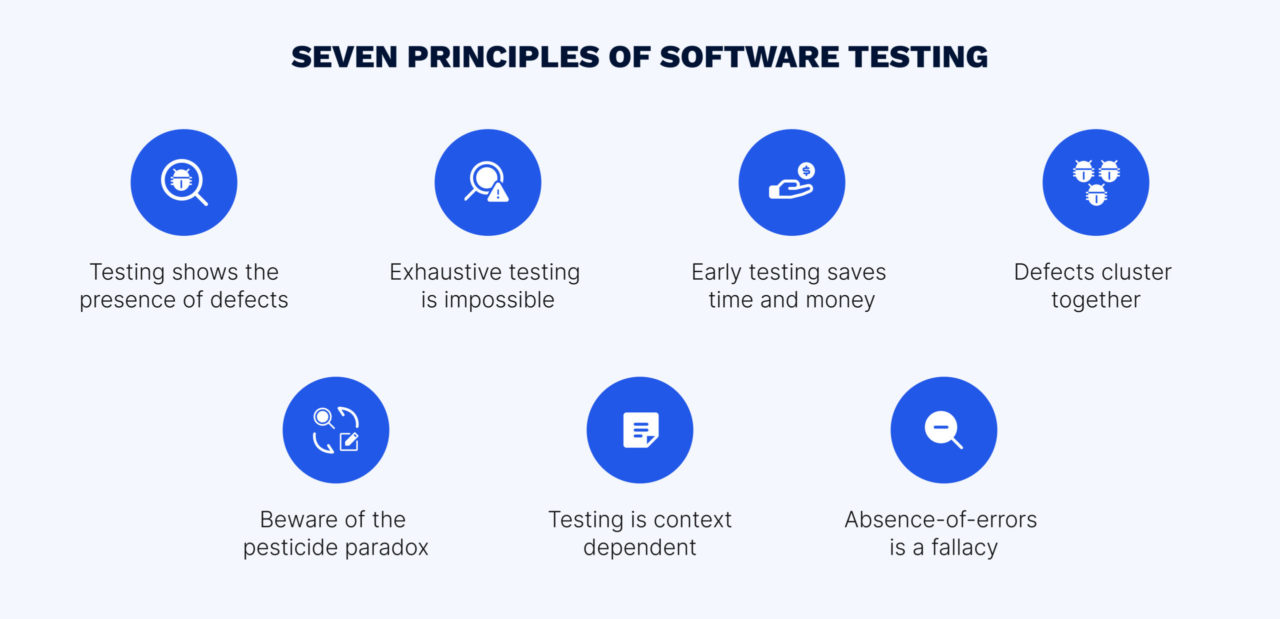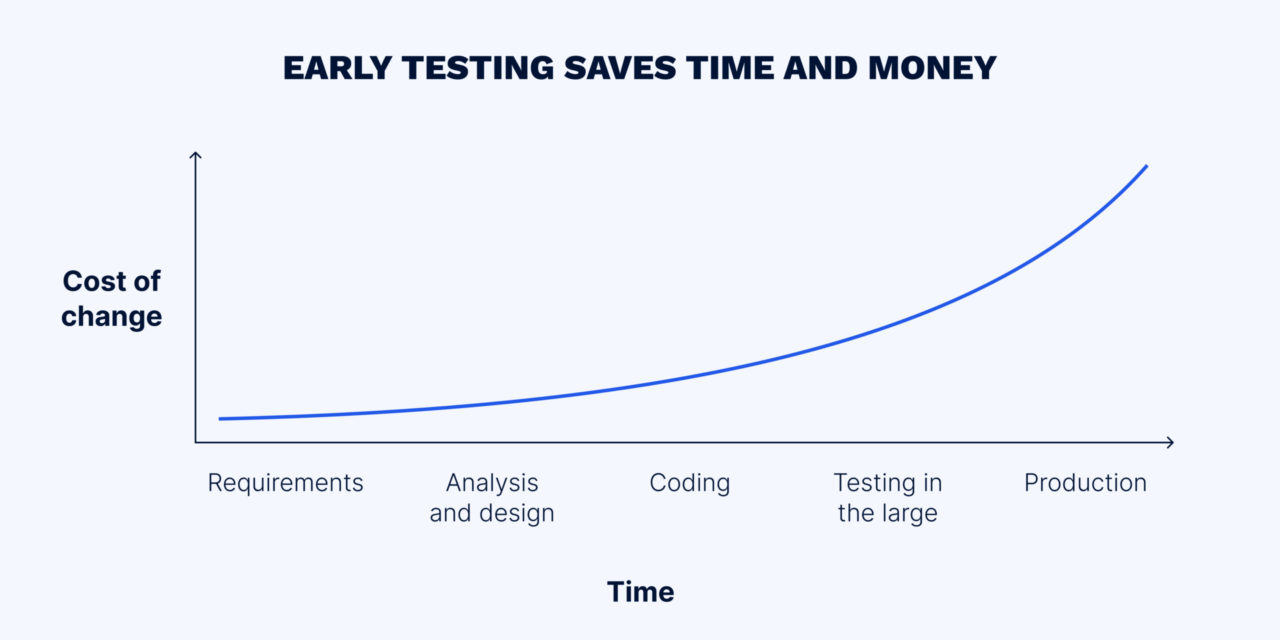
Contact us
Our team would love to hear from you.

The principles of software testing are the backbone of all testing standards, methods, and techniques and the cornerstone of the tester’s knowledge. There are seven principles that must be known not only by QA engineers but all stakeholders. Read on to learn these principles of software testing with examples.

The very essence of testing is to find ways to make sure that a product meets its requirements and to provide information about the product’s compliance with these requirements. Testing is vital for developers to fix issues, if any, before they are deployed to live environments. This reduces the number of undiscovered defects. However, even if testing is completed with no bugs found, it doesn’t prove that the product is 100% defect-free, so no matter how extensive testing is, it will never guarantee that software has zero bugs. This leads us to the next principle.
However much we would like to, it is unrealistic to test all combinations of input data values and scenarios. Trying to chase perfection will only cost you a lot of time, effort, and money. Assess risks and plan the scenarios around them to implement smart ways of testing covering vast areas while enabling the necessary confidence in the software.
Sometimes, misunderstanding of this concept can cause a client to be disappointed. That is why testers should promote the principles of testing and the processes themselves among all stakeholders. “If you align expectations with reality, you will never be disappointed.” So, be true to your team and to your clients and everything will be alright.
Testing early is vital in the software development lifecycle. Start testing as early as possible to locate software vulnerabilities. Early testing can provide huge time and money savings. The more time is spent on development, the more expensive it will be. Besides, it is cheaper to review and adjust an increment than redo the whole software.

Involve QA in every step of the software development life cycle, including analytics and development, not just when the solution is in place. In the analytics stage, a QA engineer will recognize business expectations, set critical questions for testing, and make a research plan, if necessary. This will provide the tester with a deeper understanding of the business goals and insight to better know what points to check. In turn, analysts will get quick feedback on their document so that any defects in the requirements or design can be promptly fixed.
In the development stage, testers will find the specifics of the implementation and clarify information for possible side effects. This allows developers to improve the quality of the product and reduce the chance of getting non-functional software.
We have considerable experience in the development and testing of financial apps.
Testers note that most of the defects are found in a specific functionality, while the rest of the code has fewer bugs. The more complex a module is, the more defects there are. This is a prime example of the Pareto principle in testing, which means that 80% of errors are in 20% of the product. Based on your previous experience, you can recognize the risky modules and carry out clustering for areas of major bug accumulation. Sometimes, it can save hours or days of the tester’s work. However, if you repeat the same tests over and over again, they will not help you find more errors.
In 1983, Boris Beizer defined another principle by comparing software testing techniques with the effect of a pesticide used on farms. Simply put, if you repeatedly use the same mix of pesticides to kill insects, the pests will develop resistances and this method will no longer be effective. The same applies to testing. With repetitive use of the same set of test cases, these tests will not be able to define new bugs in the system.
For example, as part of regression, a new user was constantly being registered, for which the same test was always used. After some time, existing users noticed problems with data, which is not the case for new users.
To overcome this paradox, it is necessary to regularly review and revise the tests. If required, add a new set of test cases and delete the existing ones. In the mentioned example, the solution would be to also use pre-registered users, imitating old users, and add checks for different types of data.
An experienced QA was assigned to set up testing processes on a company’s projects. The engineer enthusiastically began to change all the processes to the way they were on a completely different project. As a result, the testing and communication process were completely ruined. Why? Because the assignee didn’t take into account that each project, each team, and each person are unique variables and they require a separate analysis and interaction strategy.
This is why each type of software must be tested differently. Remember that all applications have different functions, requirements, purposes, risks, techniques, and so on. You cannot test medical software the same way you test a gaming application.
Is it possible that 99% bug free software is still unusable? The answer is yes. Finding and fixing defects doesn’t help if the system is inconvenient to use and does not fulfill the user’s needs and requirements. Testing is much more than just finding and fixing bugs.
Once, we witnessed a situation when the product owner himself created test cases. He knew the business logic, but he was not a professional tester. As a result, after releasing several versions of the product, users complained about errors. Therefore, it was decided to reduce the owner-generated cases, leaving only the critical ones, and delegate the rest to the testing team. Meanwhile, the testing team was advised to approach the application as users and find why they were uncomfortable to use it.
Remember that good testing and support is always about working with end users.
Testers have a lot of responsibility for good quality because they are the last to see a product before release. This is why they must stay focused and remember these time-proven testing principles in software engineering to utilize their time and endeavors effectively and economically. If you understand and follow these principles thoroughly, you can avoid many mistakes, misunderstandings, and unexpected situations in the future.
Carry as a flag the idea that a high quality product is our common goal, and a team’s mission is to create it with minimal costs and risks, and to do this we need to use testing at all stages of development.
Looking for a software vendor with robust expertise in testing? We are here to help you!
Our team would love to hear from you.
Fill out the form, and we’ve got you covered.
What happens next?
San Diego, California
4445 Eastgate Mall, Suite 200
92121, 1-800-288-9659
San Francisco, California
50 California St #1500
94111, 1-800-288-9659
Pittsburgh, Pennsylvania
One Oxford Centre, 500 Grant St Suite 2900
15219, 1-800-288-9659
Durham, North Carolina
RTP Meridian, 2530 Meridian Pkwy Suite 300
27713, 1-800-288-9659
San Jose, Costa Rica
C. 118B, Trejos Montealegre
10203, 1-800-288-9659